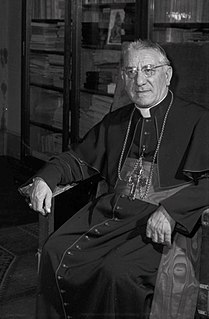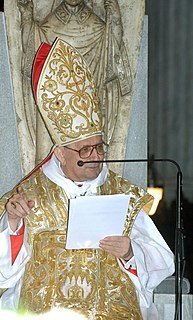
Antonio Agliardi was an Italian Roman Catholic Cardinal, archbishop, and papal diplomat.
Pope Gelasius II, born Giovanni Caetani or Giovanni da Gaeta, was head of the Catholic Church and ruler of the Papal States from 24 January 1118 to his death in 1119. A monk of Monte Cassino and chancellor of Pope Paschal II, Caetani was unanimously elected to succeed him. In doing so he also inherited the conflict with Emperor Henry V over investiture. Gelasius spent a good part of his brief papacy in exile.

The Apostolic Penitentiary, formerly called the Supreme Tribunal of the Apostolic Penitentiary, is a dicastery of the Roman Curia and is one of the three ordinary tribunals of the Apostolic See. The Apostolic Penitentiary is chiefly a tribunal of mercy, responsible for issues relating to the forgiveness of sins in the Catholic Church.

Adeodato Giovanni Piazza, O.C.D. was an Italian friar of the Discalced Carmelite Order, who became a cardinal of the Roman Catholic Church, and Patriarch of Venice, as well as a member of the Roman Curia in Vatican City.

Ulderico Carpegna was an Italian jurist and Cardinal.

Basilio Pompili was an Italian cardinal of the Roman Catholic Church. He served as Vicar General of Rome from 1913 until his death, and was elevated to the cardinalate in 1911.

The 1294 papal conclave was convoked in Naples after the resignation of Pope Celestine V on 13 December 1294. Celestine V had only months earlier restored the election procedures set forth in the papal bull Ubi periculum of Pope Gregory X, which had been suspended by Pope Adrian V in July 1276. Every papal election since then has been a papal conclave. It was the first papal conclave held during the lifetime of the preceding pontiff, an event not repeated until the papal conclave of 2013 following the resignation of Pope Benedict XVI.

Antonio Marcello Barberini, O.F.M. Cap. was an Italian cardinal and the younger brother of Maffeo Barberini, later Pope Urban VIII. He is sometimes referred to as Antonio the Elder to distinguish him from his nephew Antonio Barberini.

Alessandro Maggiolini was the Roman Catholic Bishop of the Roman Catholic Diocese of Como, Italy.

Luigi Caetani was an Italian Cardinal of the Roman Catholic Church.

Giuseppe Maria Doria Pamphili was an Italian Cardinal who served as Cardinal Secretary of State.

Enrico Caetani was an Italian cardinal.

Niccolò Caetani di Sermoneta (1526–1585) was an Italian Roman Catholic cardinal and bishop.
Consalvo Caputo was a Roman Catholic prelate who served as Bishop of Catanzaro (1633–1645) and Bishop of San Marco (1630–1633
Camillo Caetani (Gaetano) was an Italian aristocrat and Papal diplomat in several European capitals during the early Counterreformation.
Lucas Ramírez Galán, OFM was a Spanish Roman Catholic archbishop. He served as Bishop of Tui from 1770 to 1774. Previously, he served as Archbishop of Bogotá from 1769 to 1770 and Auxiliary Bishop of Cartagena from 1761 to 1769.
Antonio Caetani, iuniore (1566–1624) was a Roman Catholic cardinal.
Antonio Caetani may refer to:
Bonifazio Caetani (1567–1617) was a Roman Catholic cardinal.
Caetani is a surname. Notable people with this surname include:











